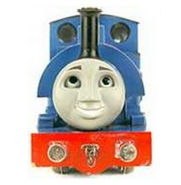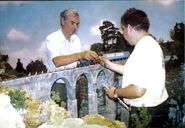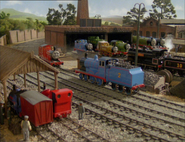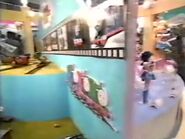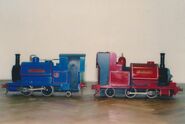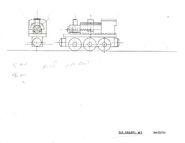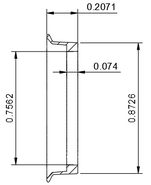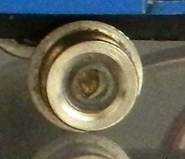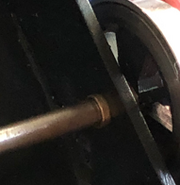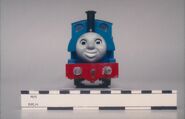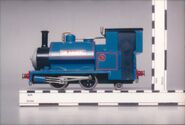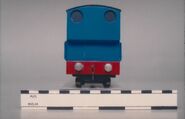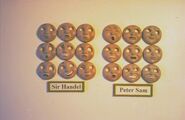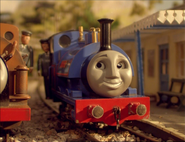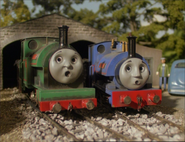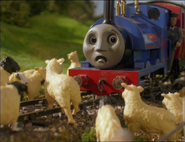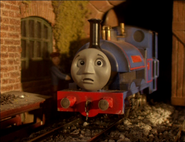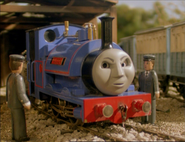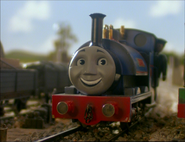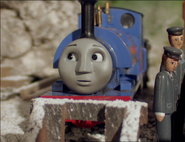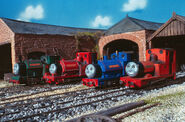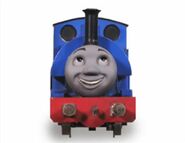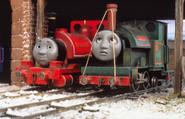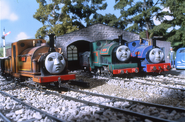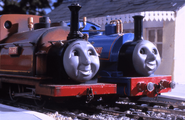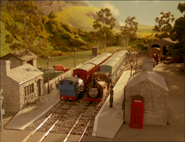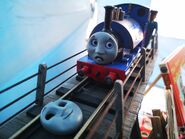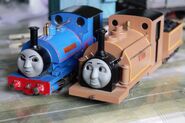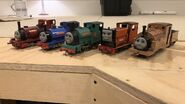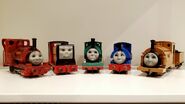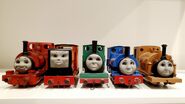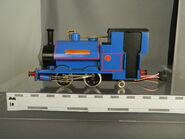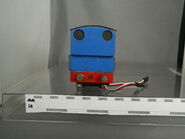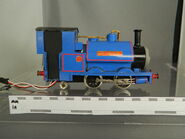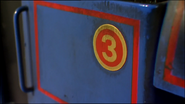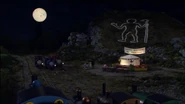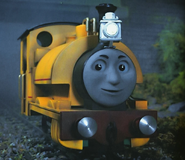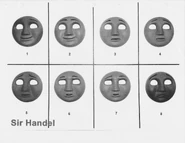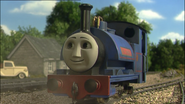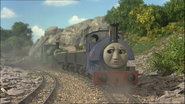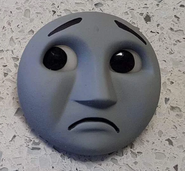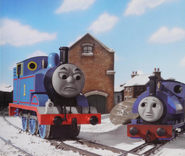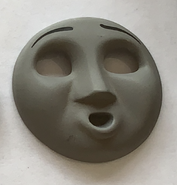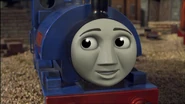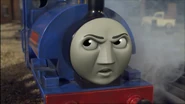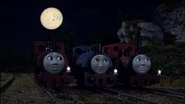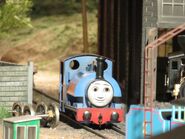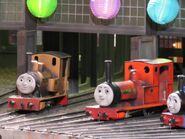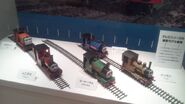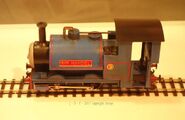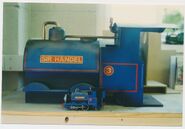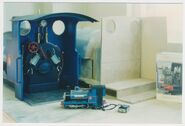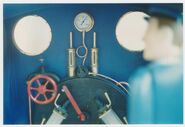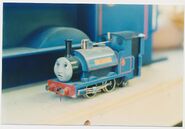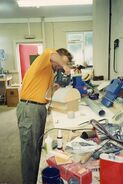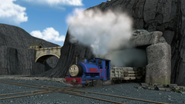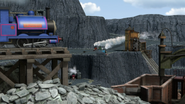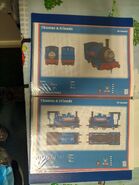
|
Background Information
Thomas & Friends
In 1995, Sir Handel was introduced in the fourth series of Thomas the Tank Engine & Friends. The series placed a great focus on the Narrow Gauge characters, with a number of stories from the original books televised. He was first introduced as Falcon on the Mid Sodor Railway and unlike The Railway Series, he kept his dark blue colour when he came to the Skarloey Railway. This was done to help make it easier for the viewers to identify the narrow gauge engines, as all Skarloey Railway steam engines were painted red in the Railway Series (except for Duke).
Sir Handel was absent in the fifth, sixth, seventh, eighth and ninth series. In canon, the reason was that he was working at the Slate Quarry. Upon returning in the tenth series, he adopted a more mature persona compared to his former pompous personality.
When the show transitioned into full CGI in 2009, the narrow gauge engines were absent for three years. Sir Handel later returned in the 2012 special, Blue Mountain Mystery, along with Skarloey, Rheneas, Peter Sam and Rusty. In the CGI series, he has shown that he is patient, humble and kind and is seen frequently working at the Blue Mountain Quarry.
Since his return in 2012, Sir Handel has been voiced by Keith Wickham (who also voices Skarloey) in both the British English and American English dubs of the series. Keith Wickham gives Sir Handel a Welsh accent, reflecting his basis' origins.
"Oldest" Engine?
Sir Handel's introduction page on the Official Website says that he is "one of the oldest engines on the Narrow Gauge Railway". But in reality, Skarloey and Rheneas, built in 1864 and 1865, are the oldest engines on the Skarloey Railway, while Sir Handel was built in 1904. Sir Handel's basis, Sir Haydn, however was built in 1878, though still after Skarloey and Rheneas.

As of the ERTL's collector card in 1996, "the oldest engine" was an adjective for Duke.
- “Brought up under instruction from Duke, the oldest of the engines.”
- ― Sir Handel's collector card on the back of ERTL's package (1996)
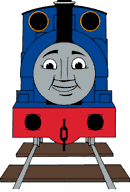
In 1997, the character introduction pages "Depot" were released on the Official Website launched by The Britt Allcroft Company.
- “Brought up under instruction from Duke, Sir Handel is one of the oldest of the engines.
Sir Handel is based on a narrow gauge [...] built in England in the 1870s.” - ― Sir Handel's "Depot" on the Official Website (1997)[1]
This happened because they misunderstood Duke's biography as Sir Handel's.

In 2002, the trading cards were written with reference to the above wording and came to refer to the entire "Narrow Gauge Railway".
- “Brought up under instruction from Duke, Sir Handel is one of the oldest engines on the Narrow Gauge Railway.”
- ― The back of Sir Handel's trading card (2002)
In the Thomas and Friends Writers' Bible from March 2003, he is stated to be older than Rusty, Rheneas and Skarloey.
- “Older than the three pals, Sir Handel is a Royal blue narrow gauge steam engine with a slightly superior attitude. The namesake of the former owner of the railway, he tends to support Duke, the oldest and wisest Narrow Gauge engine. Sir Handel is very friendly and always gives 110%.”
- ― The Thomas and Friends Writers' Bible
In 2005, the explanation about Duke was deleted from Sir Handel's introduction page on the official website.
- “Sir Handel is one of the oldest engines on the Narrow Gauge Railway.”
- ― Depot on the Official Website (2005)[2]
This description continues to be used after the site refurbishment in 2015 and continues to this day.[3]
Behind the Scenes
O gauge model (Small scale)

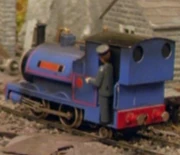
Sir Handel's small-scale model was custom built from brass by model maker Peter Eves, to run on O gauge track to a very approximate Gauge 1 Scale Standard some time before production of the fourth series. It was painted using glossy car body paint and lined with red Letraline pin-striping tape. The numbers and nameplates were custom-printed foil stickers.
For the episodes taking place on the Mid Sodor Railway, Sir Handel's nameplates were covered with black tape and overlapped with his Falcon nameplate.[4]
The model had a motor to power it mounted inside the chassis as well as an eye mechanism. There was no room to fit a smoke mechanism or the battery and receiver needed for the R/C eyes. The wires connecting to the battery, servo and receiver were usually hidden off-camera or carried in behind the engine. The eye mechanism used servos mounted in the cab, and the servos were hidden by blacking out the cab doors and windows with styrene sheets. Metal push rods went from the servos in the cab to a bracket in the smoke box behind the face, one for up and down movement and one for left and right movement. The range of movement for the eye pivot bracket was limited and often jammed. Although the model did not produce smoke, smoke was released from the set under it. The smoke tended to drift through the chassis and out the funnel to create the illusion as if they did produce smoke for a brief moment.[4]
Nearly all drivers and firemen for the small scale locomotives were cut down the middle and black tacked to the engines' cab because the servos for the eye mechanism would not allow them to stand half in the cabs.[5]
The small scale Sir Handel model was only used in the fourth series. As of 2001, the whistle broke off (this error transitioned onto his large scale model).
Parts and Construction
Drive Wheels
The drive wheels used on the model are commercially available from Slaters Plastikard.
| Part No. | Product Description | Throw | Crankpin |
| 7837MW | 3'1" 10 Spoke (M. Wardle type) (1/8" axle) | 8'5" | PB |
In order to achieve the "steam roller wheels" look referenced in the Railway Series books and television series, custom wheel treads were machined for the stock wheelsets from nickel silver stock. The treads were machined in the form of a cap that slid over the existing treads on the stock wheelsets and were permanently adhered in place. It is unclear by exactly what method they were adhered, but it is likely a Loctite-like retaining compound or a form of low melting point solder. Solder is less likely due to the heat requirements to make the bond; the plastic wheel centers are prone to melting. The coupling rod connection to the wheel centres had to be 'bushed out' using two brass 12BA nuts due to the increased thickness of the wheel tread. The extended coupling rod connection point introduced natural rotational clearance for the secondary crankpin hole on wheel centres and prevented the need to remove them. This feature makes Sir Handel the only small scale narrow gauge steam locomotive model to retain all crankpin holes on the Manning Wardle wheelsets.
A notable visual difference between modern commercially available versions of all Slaters Plastikard wheelsets and the ones on the small-scale Sir Handel model is the axle mounting design. When the model was originally built (sometime before 1994), Slaters supplied wheel sets with axles that had a 'D' shape on both ends to assist the model builder with wheel quartering. The plastic wheel centre bushings had a corresponding "D"-shaped hole where the axle would be pressed in and held by friction. Eventually, the shape of the axle ends was changed to a square, and a tapped hole was placed in both axle ends for a countersunk retaining screw. This change was cited by Slaters as being made so that it would be easier for the modeller to take the wheels on and off the axles repeatedly. The legacy wheelsets with "D"-ended axles are no longer available.
Trailing Wheel
The trailing 'pony' wheel was custom machined from nickel silver stock. A hole was drilled through the centre of the wheels during the machining process. A flanged nylon bushing was also machined and pressed into the holes in the centre of the wheels from the back side to insulate the wheels from the 1/8" steel axle and prevent an electrical short circuit.
Motion
The side rod motion on the Sir Handel model was comprised of a mix of custom-made parts and heavily modified commercially available components from Tri-ang. The coupling rod was custom made out of 0.04-inch-thick brass sheet metal and was plated using a nickel-silver anode to create a steel-like appearance. The coupling rods were fabricated slightly too long for the wheelbase, which led to poor running quality. The model makers intentionally introduced bends in the rods in an attempt to shorten them to prevent the model from jamming during operation. This worked well enough to complete the filming of the fourth series. A steel 12BA cheesehead screw and brass crankpin bushing were used to secure the rods to the rear drive wheel (both are supplied with wheelsets from Slaters Plastikard). A brass 12BA flat-head screw and steel washer were used to secure the coupling rod to the front drive wheel. The connecting rod and crosshead were sourced from an old Tri-ang Princess OO-scale steam locomotive model and were modified to move the connection point to the outside of the crosshead. This was done to create additional clearance for the coupling rod as the wheels would rotate behind the crosshead. A brass nut was used to replace the riveted connection point that was present on the stock triangular crosshead. The cylinders were custom machined from brass bar stock, and the crosshead slide bars were 1.5-mm-diameter brass rods that were also plated in nickel. The crosshead slide bars, as well as the crosshead piston, were bent into mirroring "S" shapes to increase clearance behind the crosshead as well.
Buffers
Buffers were also sourced from Slaters Plastikard. The buffer housings were LNER/SR Stepped Parallel buffers. However, the steel buffer heads that are supplied with the LNER 7909 buffer set are too large and were not used. Instead, they were swapped out with buffer heads supplied with the GWR Collett Parallel 7906 buffer set offered at Slaters. All small-scale narrow gauge steam locomotives used this size of steel buffer head. Additionally, multiple other steam locomotives used the buffer housings from the GWR 7906 set. This swap was likely the natural result of excess parts ordered when all of the narrow gauge steam locomotives were built. Although Slaters buffers are normally spring-sprung, the ones on the Sir Handel model are not. The rear buffers went through the buffer beam and screwed directly into the rear of the chassis, acting as the main way the locomotive body was mounted to the chassis at the rear. The front buffers were adhered in place, likely due to the main chassis frames and cylinders being in the way of any springing action.
| Part No. | Product Description |
| 7909 | LNER/SR Stepped Parallel |
| 7906 | GWR Collett Parallel |
Couplings
Couplings were again sourced from Slaters Plastikard. All small-scale narrow gauge locomotives used the standard 3-link coupling set, part number 7155. An important note is that the 7155 coupling set was updated to include a thicker 'cast' coupling hook sometime in the years after the fourth series was released on film. The locomotive models in the show used the 'etched' version of the hook. Some customers report being able to still get the 'etched' version of the hook if they add a note during the checkout process. Alternatively, the etched hook is still offered by default in the M7025 'Instanter' coupling set. Interestingly, the etch that is provided as a part of the M7025 set still has the 7155 part number etched into the fret. The etched couplings come with springs to enable modellers to create spring-sprung coupling hooks, but none of the locomotive models in the small-scale narrow gauge range utilised any springing features. Instead, they were soldered firmly in place and trimmed flush on the inside of the buffer beams. The standard ring links provided in either set were used for coupling rolling stock to the model on either end.
| Part No. | Product Description | Notes |
| 7155 | 3 link coupling with cast brass hooks and steel links and springs [Pair] | Provided with high-detail cast coupling hook (etched version available upon request at checkout) |
| M7025 | Instanter Couplings [Pair] | Provided with 7155 etched hook fret |
Chassis
The chassis for the Sir Handel model was completely custom fabricated from 0.064"-thick sheet brass. It utilised a 7/8" internal frame spacing with a 1/4" diameter cylindrical brass spacer at the front end. At the rear, a piece of sheet metal bent into a 'U' shape acted as the rear frame spacer and was soldered permanently in place between the frames. The 'U' shape acted as a small compartment and was utilised to hide servo motor wiring for the eye mechanism. A cross beam was soldered to the rear end of the chassis to allow the rear buffers to screw into it, allowing the body to be mounted at the backside of the model. The cylindrical frame spacer at the front end had a cross-hole drill through it. A screw was passed through it and threaded up into the locomotive body. This created a secure mounting point for the front end of the body. A custom gearbox was fabricated out of a dark plastic material of unknown composition and mounted between the frames, acting as a very large spacer and support point for the centre portion of the chassis. It held a "can"-style model train motor, which had a plastic worm gear mounted on the shaft. The worm gear directly engaged a plastic spur gear on the front drive axle. Direct worm drive mechanisms like this are notorious for poor operation, but space constraints inside the model left few other options on the table. It is unclear if the gearing was custom machined or if the gears were purchased from a third party. An interesting feature of the Sir Handel model's chassis is the axle bushings that were used. No other small scale narrow gauge locomotive utilised axle bushings. It is unclear why they were added, but the axle bushes are commercially available from Slaters Plastikard. Track power was supplied from the wheels to the motor using Slaters Plastikard plunger pickups.
| Part No. | Product Description |
| 1212 | Locomotive Frame Bushes 1/8" Bore [20 per packet] |
| 7157 | Loco Plunger Pickups [Set of 6] |
Reference Sheets
Series 4
Series 8
Faces
Ten different facial expressions were sculpted for Sir Handel's small scale model and used on-screen, although only in the fourth series. The faces were first sculpted in clay and from that resin casts were made using a silicone mould.[6]
Reference Sheets
Usage and Evolution
In various promotional material, the nameboards title sequence and a fourth series reference sheet, he and Rheneas have incorrectly worn each other's happy faces. This error also transitioned onto Rheneas' Wooden Railway toy. In the 2004 merchandise referencing promo of Sir Handel, he incorrectly wears Skarloey's laughing face. The incorrect face was later depicted on Sir Handel's Pocket Fantasy toy. Sir Handel's faces have also been worn on Peter Sam and Duke.
Present Day
After production of the model series ended in 2008, most of Sir Handel's faces (except his happy face) were put into storage, with them being listed as "TF01655".
Five of Sir Handel's faces are now owned by Twitter and Instagram user ThomasTankMerch. Additionally Sir Handel's shocked face would be exhibited at the History of Thomas and Awdry Extravaganza events and his horrified face would be exhibited at the Halloween Clearwater Event and worn on a fan-made replica. His laughing, sad and cross faces are currently still in storage alongside the horrified and shocked faces (when they are not being used at events). In February 2023 a prototype face for Sir Handel would be sold by The Prop Gallery, which is now owned by Twitter user TheThomasFan.
Present Day
After production of the model series wrapped in 2008, most of the models and sets would be put into storage, with some being put on display at Drayton Manor Theme Park. All other models would be logged and referenced from 2010 until early 2011 by HiT Entertainment. From this HiT would decide on which models were to enter storage once again, which would be given to crew members and which would be disposed off. Due to the larger models being more frequently used at the time, Sir Handel's small scale model would be disposed off by the company in favour of the large scale model, which would stay under HiT and later Mattel's ownership.
As of 2018, Sir Handel's small scale model, along with his happy, smiling, smirking, angry and neutral faces and nameboard (with the nameboard being supplied by TomsProps) are now owned and preserved by Twitter and Instagram user ThomasTankMerch (TTM). The first received, Sir Handel's model was missing the number plate decals which were presented in the eighth series reference photos. Reproductions were made to replace the lost decals which were scaled down to closely match the size of the originals with the help of using the fourth series reference photos. Another part of the model that needed to be replaced was one of the siderods, which mysteriously disappeared prior to TTM's acquisition. In 2019, the model was exhibited at the Edison train show alongside various other props from ThomasTankMerch's collection.
A replica of Sir Handel's small-scale model (made by Twitter user SkarloeyRailwayAdventure) is also currently on display at Drayton Manor.
Present Day Ruler Reference Photos
O gauge model (Large scale)


Unlike most of the narrow gauge engines, Sir Handel's large scale model was not built until 2005 due to financial reasons. Although there were attempts to build a model as far back at the sixth series, this never came to fruition. The large scale models replaced their small scale counterparts and provided ease of filming and reliability. The Sir Handel model was exclusively used between the tenth to twelfth series. This model was built to a larger scale than the gauge 1 engines and ran on O gauge track. They were close to 16mm scale, but slightly larger.[5]
The model was made from brass. The wheels and chassis were custom machined (CNC). The model was track powered, so pickup contacts were attached to the metal wheels, which ran into the motor to power it. The electricity ran from the track to the wheels/pickup contacts and went into the motor to power him. The model was also fitted with a smoke unit.
The eye mechanism had two servos, one for up and down movement and one for left and right movement. The up/down servo was attached to the body. The left/right servo had a rod attached to the arm, which connected to a bracket. The eye balls were coupled to the bracket and locked in by the face-plate, so whenever the servos were powered, the eye balls would move however the crew member desired.
Before Sir Handel returned in the tenth series, the large scale model's body was used in the ninth series for the character Proteus. The chassis for Sir Handel was not built at the time, so Proteus reused Peter Sam's chassis and the cylinders were significantly larger than Sir Handel's. A cast of Sir Handel's model was later made for Proteus' Statue seen in the twelfth series episode, Mountain Marvel.
Faces
Eight different facial expressions were sculpted for Sir Handel's large scale model, although only six were used on-screen with two of which, his clenched and wincing faces were left unused. The faces were first sculpted in clay by Sean Hedges-Quinn and from that resin casts were made of a silicone mould. Following this a few faces would be test painted and using those as examples, the final on-screen variants would be produced. Some faces were duplicates of the same expression casts with slightly different eyebrows to produce different emotions.[7]
Reference Sheets
Usage and Evolution
Present Day
Sir Handel's large scale shocked face would be put on display at the 'History of Thomas & Friends' exhibition at the Midland Railway Centre in May 2019. The face would also later be redisplayed at the Awdry Extravaganza in 2021. The earliest finished versions of Sir Handel's large scale clenched, shocked and sad faces are also currently owned by Sean Hedges-Quinn.
CGI Face
The twelfth series marked the beginning of the show's transition into CGI and the characters' faces were animated through CGI with the aid of motion capture animation. The physical models' moulded faces were replaced by white targets with triangles to fix a computer-animated face in post-production. Sir Handel's resin faces were only used in background shots.[8]
In the twelfth series episode, The Man in the Hills, Sir Handel was briefly seen with a lamp. This was powered by a hidden battery pack.
Model Changes
Sir Handel's large scale model underwent many changes and had differences from its small scale counterpart. These include:
- Series 10:
- He slightly increased in size.
- He received a darker blue livery.
- His grey trailing wheels and buffers became black.
- His smokebox, boiler and saddle tanks were raised up and a stand under his smokebox was added.
- His square buffer housings changed to round ones.
- His nose was not as pointed.
- He received a permanent tail lamp.
- His saddle tank became wider.
- His eyebrows changed shape.
- As Sir Handel's whistle on the small scale model broke off prior to 2001, no visible whistle is seen on the large scale model. His whistle sound also changed.
- Series 11:
- The sides of his cab openings were blacked-out.
- Series 12:
- The sides of his cab were opened-out again.
Present Day
Sir Handel's large scale model is now currently on display at the Hara Model Railway Museum in Japan and is currently wearing his smiling face.
A set of spare unused number decals from production of the sixth series which were set to be used on Sir Handel's (to be constructed at the time) large scale model are also currently owned by Twitter user TomsProps.
Close-up model

A larger scale model of Sir Handel was built in the fourth series. It was required for scenes where he had to interact with the close-up scale figures in or near his cab. Smoke would emit from the whistle and firebox when required.
The cab was made in pieces so it was able to be dismantled and reassembled for use of interior shots if required. Most of the close-up scale models did not have faces seeing as most of the time the models were not complete, on top of the fact the faces would often never need to be seen in this scale.
Unlike both his O gauge models, Sir Handel's front and back cutout windows had glass.
Sir Handel's close-up model only appeared in the fourth series. Though not shown on-screen, Sir Handel's close-up model reused Skarloey's cab controls and firebox.
Between production of the fourth and twelfth series, a new close-up model would be built of Sir Handel's cab, where this model would feature no removeable parts and never appeared on screen. Interestingly, unlike the original model, this model did not feature floorboards inside the cab.
Present Day
After production of the model series ended in 2008, Sir Handel's new close-up model and rear piece of the original close-up model were put into storage, and they were listed as "TF00711".
Sir Handel's new close-up model and rear piece of his original close-up model are currently still in Mattel's storage unit in Southampton, England. Unusually, Sir Handel's original close-up model's floorboards are stored inside of Duncan's close-up model's cab.
CGI model


In 2009, the series introduced Computer-Generated Imagery (CGI) as a replacement for the show's long-standing live-action models. Sir Handel was recreated from scratch in CGI by Nitrogen Studios in 2010 for production of the 2012 special Blue Mountain Mystery. His model was "hand-sculpted" in Maya, a 3D animation and modelling software.[8]
Photographs of Sir Handel's large scale model were used for referencing. According to Greg Tiernan, every detail of the original television series models for each character is carefully reproduced in the CGI model. The models are subjected to many rounds of review before they are submitted to HiT Entertainment for final input and approval.[8]
In addition, Nitrogen Studios went to the Talyllyn Railway and took measurements of Sir Handel's basis, Sir Haydn, so that his CGI model would resemble Sir Haydn as closely as possible.
Sir Handel has had modifications throughout the CGI era. These include:
- Blue Mountain Mystery:
- His blue livery became a more vibrant shade than it was in the tenth series.
- His buffers and trailing wheels became grey again.
- His buffer housings became square again and more accurate to his basis.
- His whistle became visible again.
- Dark brass handrails along his saddle tank were added.
- His cutout windows gained brass frames and contained glass.
- His lubricating boxes gained lids on top and brass taps on the sides.
- His tail lamp was positioned higher and changed to a removable Talyllyn-styled lamp.
- He received sanding gear under his cab.
- Rivets were added to his bufferbeam and cab.
- He gained angle brackets on the back of his cab.
- He received black siderod guards.
- He received brass pipes under his saddle tank.
- Series 18:
- A permanent lamp and lamp irons were added.
- The Great Race:
- His trailing wheels and saddle tank hand rails became silver (or more reflective).
The following pantone colours are used on Sir Handel's CGI model:
- ■ PMS 2728 (blue)
- ■ PMS 191 (pink-red)
- ■ PMS 186 (red)
- ■ PMS (black)
- ■ PMS 873 C (gold)
- ■ PMS 877 C (silver)
Reference Sheets
Voice Actors
- Keith Wickham (UK/US; Blue Mountain Mystery - twenty-fourth series)
- Naoki Tatsuta (Japan; fourth series only)
- Bunkō Ogata (Japan; tenth and eleventh series)
- Shōto Kashii (Japan; Blue Mountain Mystery - twenty-fourth series)
- Daniel Montoya (Germany; Blue Mountain Mystery - sixteenth series)
- Marcus Just (Germany; seventeenth series only)
- Kai-Hendrik Möller (Germany; The Great Race onwards)
- Jan Kulczycki (Poland)
- Paul Disbergen (The Netherlands)
- Nir Ron (Israel; Saving Time only)
- Per Skjøldsvik (Norway; Blue Mountain Mystery only)
- Helge Winther Larsen (Norway; sixteenth - seventeenth series)
- Miguel Ángel Leal (Latin America; Blue Mountain Mystery - twentieth series)
- Gustavo Carrillo (Latin America; twenty-fourth series)
- Fernando Castro (Spain; Blue Mountain Mystery onwards)
- Alexander Kotov (Russia; sixteenth series only)
- Prokhor Chekhovskoy (Russia; seventeenth series only)
- Taisto Oksanen (Finland; Blue Mountain Mystery onwards)
- Loukas Frangoulis (Greece)
- Francisco Júnior (Brazil; twentieth series only)
- Caio César Nunes (Brazil; twenty-fourth series only)
References
- ↑ 1997 Sir Handel's page on the Official Website
- ↑ 2005 Engine Depot (See "About" tab on "Sir Handel" page) on the Internet Archive
- ↑ 2015 Sir Handel's page on the Official Website
- ↑ 4.0 4.1 Season 4 narrow gauge explained on ThomasTankMerch's blogspot
- ↑ 5.0 5.1 Robert Gauld-Galliers' interview with Sodor Island Fansite
- ↑ A Guide to the Faces on ThomasTankMerch's blogspot
- ↑ TomsProps on Twitter
- ↑ 8.0 8.1 8.2 Greg Tiernan's interview with Sodor Island Fansite





